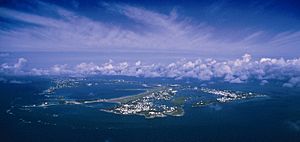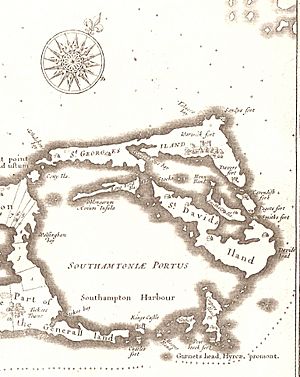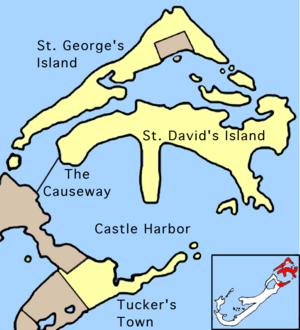St. David's Island, Bermuda facts for kids
St. David's Island is one of the main islands that make up Bermuda. It's located in the far north of the territory. This island is one of two similar-sized islands that form most of St. George's Parish.
Contents
What is St. David's Island?
St. David's Island is a special part of Bermuda. It was named by early British settlers. They chose the name to honor Saint David, who is the patron saint of Wales. This is similar to how the nearby St. George's Island was named after the patron saint of England.
How Big is St. David's Island?
Originally, St. David's Island was about 503 acres (2.04 square kilometers) in size. However, during World War II in 1942, the island was made much larger. Workers added land and connected it to other smaller islands like Long Bird Island and Cooper's Island.
After this work, the island grew to about 650 acres (2.6 square kilometers). This was done to make space for a United States military base. This base was first called Fort Bell/Kindley Field. It was used by the US Army and the British Royal Air Force during the war. Later, it became Kindley Air Force Base and then Naval Air Station Bermuda. This base took up more than half of the island's land under a 99-year lease.
What Happened to the Military Base?
The military base on St. David's Island closed in 1995. The land was then given back to Bermuda. Today, many of the buildings and facilities from the old base are used as part of L.F. Wade International Airport.
Cooper's Island is now physically connected to the southeast part of St. David's. Even though they are joined, many people still think of them as separate islands.
Where is St. David's Island Located?
St. David's Island is separated from St. George's Island by two bodies of water. These are Ferry Reach in the southwest and St. George's Harbor in the northeast.
The island is also separated from the main part of Bermuda by the waters of Castle Harbor in the south. However, it is connected to the main island by a road called The Causeway.
What are the Main Features of St. David's Island?
St. David's Island has several important and interesting places:
- St. David's Head: This is the easternmost point of all of Bermuda.
- St. David's Battery: This is an old military fort located on Great Head, which is part of St. David's Head.
- L.F. Wade International Airport: This is Bermuda's main airport, using many of the facilities from the old US military base.
- St. David's Lighthouse: A famous lighthouse that helps guide ships.
- Annie's Bay: A beautiful bay located on Cooper's Island, which is now connected to St. David's.
St. David's Island is also connected to the United States by a special underwater fiber optic cable. This cable is called 360 Americas and helps with internet and communication.
See also
 In Spanish: Isla Saint David (Bermudas) para niños
In Spanish: Isla Saint David (Bermudas) para niños




